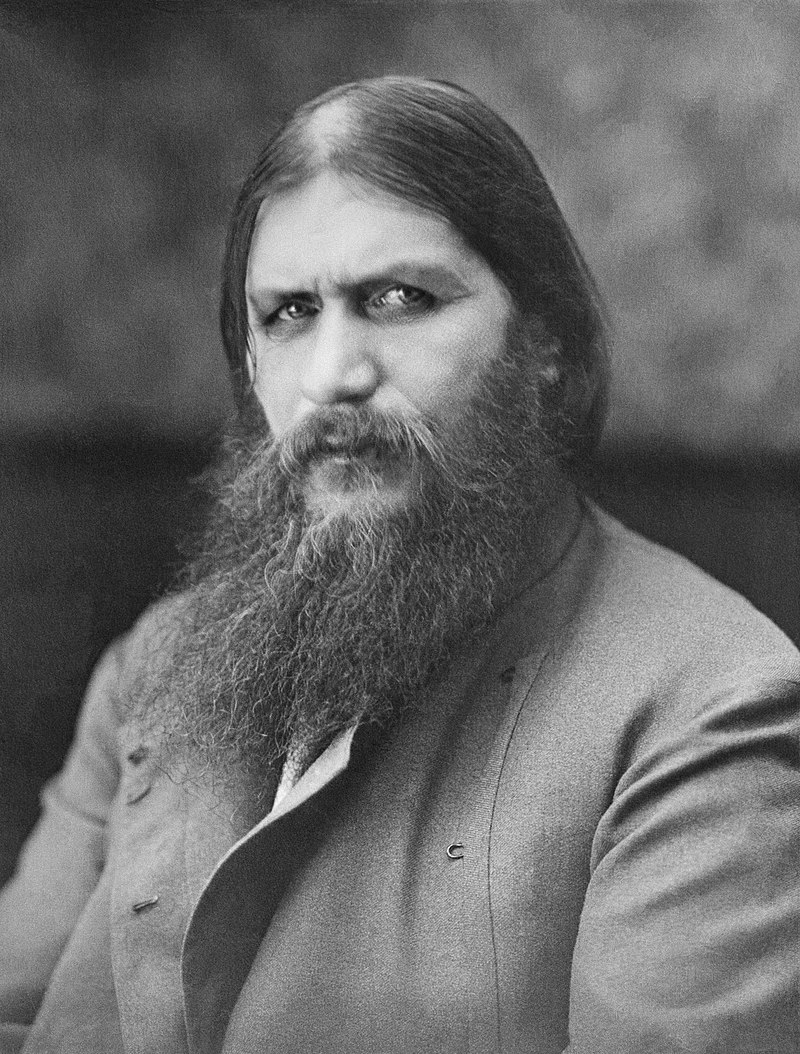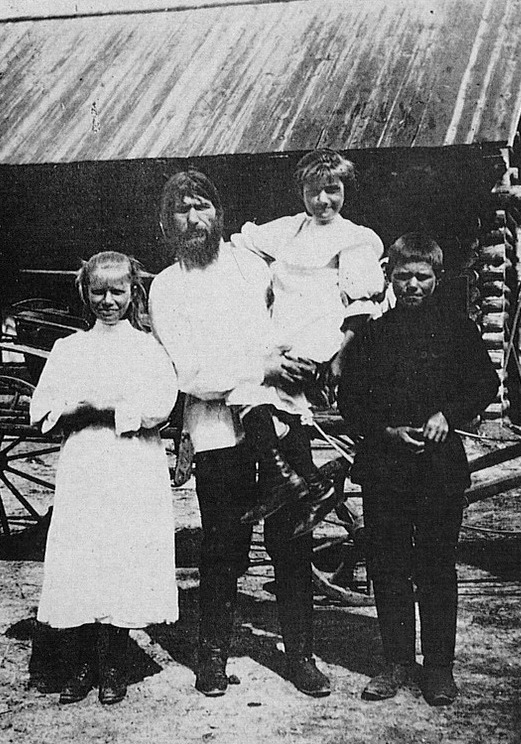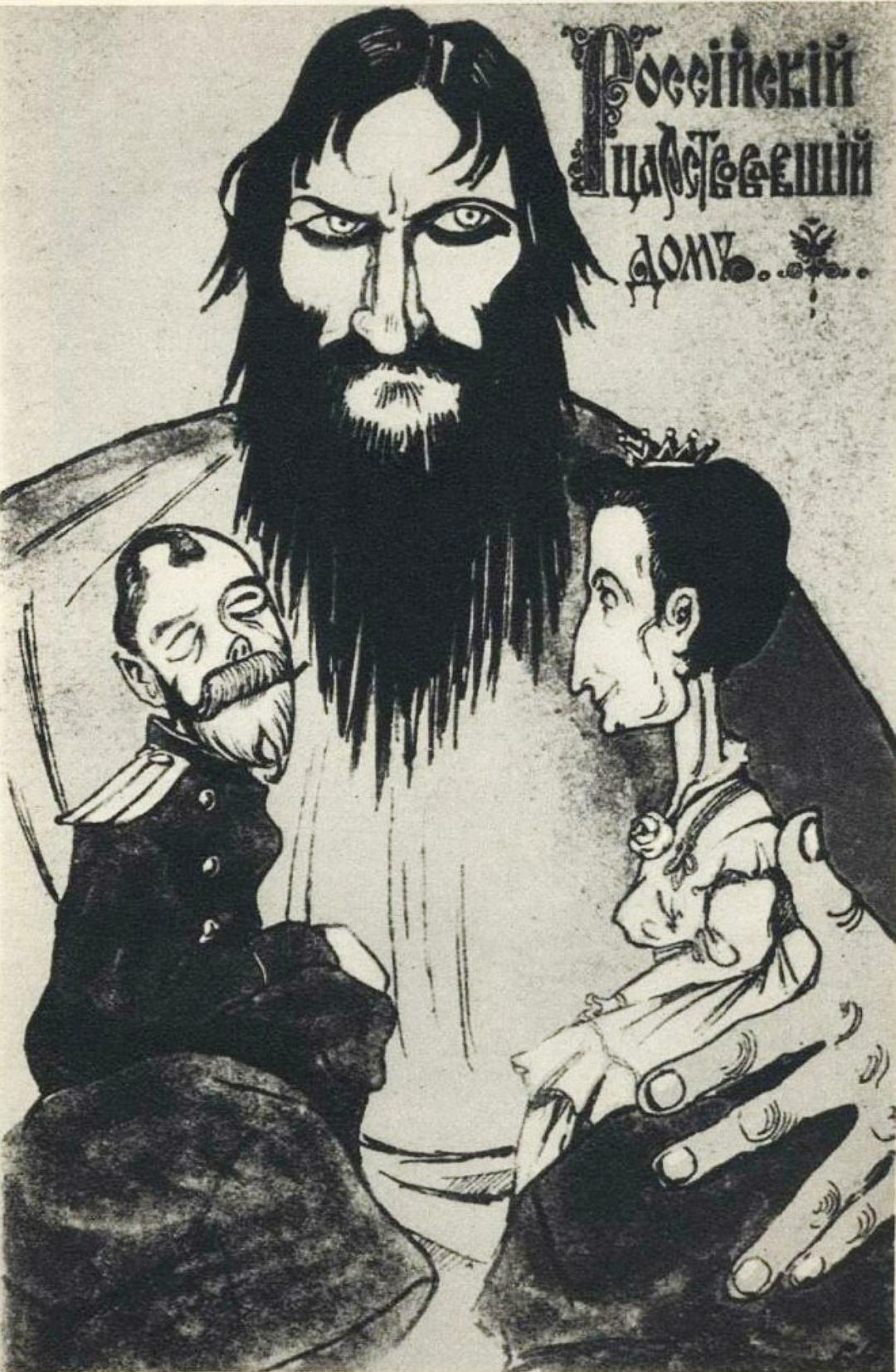by Susan Flantzer
© Unofficial Royalty 2021

Grigori Yefimovich Rasputin; Credit – Wikipedia
Favorite: a person treated with special or undue favor by a king, queen, or another royal person
Patronymics
- In Russian, a patronymic is the second name derived from the father’s first name: the suffix -vich means “son of” and the suffixes -eva, -evna, -ova, and -ovna mean “daughter of”.
Grigori Yefimovich Rasputin was born on January 21, 1869, in the village of Pokrovskoye in the Tobolsk province of Siberia, Russia. His father Yefim Yakovlevich Rasputin (1841 – 1916), a peasant farmer and a coachman, and his mother Anna Vasilievna Parshukova (1839 – 1906) were married in 1863. The couple had seven other children but all of them died in infancy and early childhood.
Like most Siberian peasants, Rasputin was not formally educated and remained illiterate until his early adulthood. Local records suggest Rasputin exhibited unruly behavior while growing up, possibly drinking, small thefts, and disrespect for local authorities. In February 1887, Rasputin married Praskovya Feodorovna Dubrovina, a peasant girl. Praskovya remained in Pokrovskoye, Rasputin’s hometown, throughout Rasputin’s later travels and his rise to prominence. She remained devoted to him until his death.

Rasputin and his children; Credit – Wikipedia
Rasputin and Praskovya had seven children but only three survived to adulthood:
- Dmitry Grigoriovich Rasputin (1895 – ?)
- Matryona (Maria) Grigorievna Rasputina (1898 – 1977), married (1) Boris Soloviev, had two children, divorced (2) Gregory Bernadsky, no children, divorced
- Varvara Grigorievna Rasputina (1900 – ?)
After the 1917 Russian Revolution, Rasputin’s daughter Matryona emigrated to France and later moved to the United States where she died in Los Angeles, California in 1977. In 1920, the property of Rasputin’s son Dmitry was confiscated and nationalized by the Soviet Union government. Rasputin’s widow Praskovya Feodorovna, his son Dmitry, and his daughter Varvara were deprived of their voting rights in 1922 because they were considered “malicious elements.” In the 1930s, all three were arrested by the NKVD, which committed mass executions without trial and administered the Gulag system of forced labor camps in Siberia during the regime of Joseph Stalin. The trace of all three was lost in the labor camps.
In 1897, Rasputin developed a renewed interest in religion and left his hometown Pokrovskoye to go on a pilgrimage. At that time, Rasputin was twenty-eight years old, married for ten years, and had a young son with another child on the way, so it would seem like an odd time for him to leave his family. Various sources suggest he left to escape punishment for his role in a horse theft, or perhaps he had a vision of the Virgin Mary or St. Simeon of Verkhoturye, or he was inspired by a young theological student he had met. Earlier, Rasputin had undertaken shorter pilgrimages but this pilgrimage to the St. Nicholas Monastery in Verkhoturye transformed him. After spending several months at the monastery, Rasputin returned to his village as a changed man. He looked disheveled, became a vegetarian, stopped drinking alcohol, and fervently prayed and sang hymns.
Rasputin spent the next several years as a strannik, a holy wanderer or pilgrim. He left Pokrovskoye for months or even years to wander the country and visit holy sites. By the early 1900s, Rasputin had developed a circle of followers in Siberia. After visiting Kazan, local church officials gave him a letter of recommendation to Ivan Nikolayevich Stragorodsky, known as Bishop Sergei, the rector of the St. Petersburg Theological Seminary at the Alexander Nevsky Monastery, and arranged for him to travel to St. Petersburg. Once in St. Petersburg, Rasputin met Russian Orthodox church officials including Archimandrite Theofan, who was so impressed with Rasputin that he invited him to stay in his home. It was through Theofan that Rasputin attracted some of his early and influential followers in St. Petersburg.

Rasputin surrounded by his admirers in St. Petersburg; Credit – Wikipedia
According to Rasputin’s daughter Matryona, he was never a monk, but a starets. Merriam-Webster dictionary defines a starets as a spiritual adviser who is not necessarily a priest, who is recognized for his piety, and who is turned to by monks or laymen for spiritual guidance. Rasputin, who was more of a mystical faith healer, was styled starets by his followers, although he was not officially recognized as one by the Russian Orthodox Church.
By 1905, Rasputin had formed friendships with several members of the aristocracy, including the sisters Princess Militsa and Princess Anastasia (Stana) of Montenegro, who had both married into the Russian Imperial Family and were instrumental in introducing Rasputin to Nicholas II, Emperor of All Russia and his family. On November 1, 1905, Rasputin’s first personal meeting with Nicholas II, Emperor of All Russia and his wife Empress Alexandra Feodorovna, a granddaughter of Queen Victoria, born Princess Alix of Hesse and by Rhine, took place and was noted in Nicholas’ diary: “At 4 o’clock we went to Sergievka. We drank tea with Militsa and Stana. We made the acquaintance of a man of God – Grigori, from Tobolsk province.”
After giving birth to four daughters during the first seven years of her marriage, Empress Alexandra Feodorovna felt great pressure to provide an heir. Finally, in 1904, she gave birth to a son, Tsesarevich Alexei Nikolaevich. However, it would soon become apparent that she was a carrier of hemophilia, and her young son was a sufferer. This would cause immense emotional pain to Alexandra, and great measures were taken to protect Alexei from harm and to hide the illness from the Russian people. When Alexei’s illness eventually became public knowledge, it led to more dislike for Alexandra, with many of the Russian people blaming her for the heir’s illness.

Alexandra Feodorovna with her children, Rasputin & nurse Maria Ivanova Vishnyakova in 1908; Credit – Wikipedia
After working with many physicians to help Alexei who suffered greatly, Alexandra turned to mystics and faith healers. This led to her close, disastrous relationship with Grigori Yefimovich Rasputin. Several times Rasputin appeared to have brought Alexei back from the brink of death, further cementing Alexandra’s reliance on him. To many historians and experts, this relationship would contribute greatly to the fall of the Russian monarchy. It is unclear when Rasputin first learned of Alexei’s hemophilia or when he first acted as a healer. There is documentation that Alexandra summoned him to pray for Alexei when he had an internal hemorrhage in the spring of 1907. Alexei recovered the next morning.

Alexandra and Alexei, circa 1911; Credit – Wikipedia from the Beinecke Library
The most mysterious episode of Rasputin’s legend occurred during the summer of 1912. Alexei developed a hemorrhage in his thigh and groin after a bumpy carriage ride near the Imperial Family hunting lodge at Spala, then in the Russian Empire, now in Poland. After the hemorrhage developed into a large hematoma, Alexei was in severe pain, delirious with fever, and close to death. Rasputin was in Siberia and Empress Alexandra asked Anna Vyrubova, her lady-in-waiting and close friend, to send him a telegram asking him to pray for Alexei. Rasputin quickly sent back a return telegram, telling Alexandra, “God has seen your tears and heard your prayers. Do not grieve. The Little One will not die. Do not allow the doctors to bother him too much.” Although Alexei’s condition did not change during the next day, Alexandra was encouraged by Rasputin’s words and regained some hope that Alexei would survive. The following day, Alexei’s bleeding stopped. One of the physicians who attended Alexei in Spala admitted that “the recovery was wholly inexplicable from a medical point of view.” He later admitted that he could understand how Alexandra could see Rasputin as a miracle worker: “Rasputin would come in, walk up to the patient, look at him, and spit. The bleeding would stop in no time. How could the empress not trust Rasputin after that?”

Rasputin, Nicholas, and Alexandra, anonymous caricature in 1916; Credit – Wikipedia
The belief of Nicholas II’s family in Rasputin’s healing powers brought him considerable status and power at court. He was suspected of exerting political influence over Nicholas II and was even rumored to be having an affair with Alexandra. Opposition to Rasputin’s influence grew within the Russian Orthodox Church. Even Imperial Family members became concerned with Rasputin’s influence when Nicholas II left St. Petersburg to take supreme command of the Russian armies fighting in World War I, leaving Alexandra in charge as Regent.


Grand Duke Dmitri Pavlovich of Russia and Prince Felix Felixovich Yusupov; Credit Wikipedia
Eventually, a group of conspirators plotted to murder Rasputin hoping to his influence over Nicholas II’s family. The conspirators were led by two men, one a member of the Imperial Family and one who married into the Imperial Family. Grand Duke Dmitri Pavlovich of Russia was the second child and only son of Grand Duke Paul Alexandrovich (a son of Alexander II, Emperor of All Russia) and Princess Alexandra of Greece (a daughter of King George I of Greece and Grand Duchess Olga Konstantinovna of Russia). Therefore, Dmitri was the first cousin of Nicholas II as their fathers were brothers. (A side note, Dmitri was also the first cousin of Prince Philip, Duke of Edinburgh as Dmitri’s mother and Philip’s father were siblings.) Prince Felix Felixovich Yusupov was a Russian aristocrat who was wealthier than any Romanovs. Felix married Princess Irina Alexandrovna of Russia, Nicholas II’s only niece, the daughter of his sister Grand Duchess Xenia Alexandrovna of Russia and Grand Duke Alexander Mikhailovich of Russia.
Along with Dmitri and Felix, Vladimir Purishkevich, a deputy of the Duma, the Russian legislature, was one of the main conspirators. Other participants were Dr. Stanislaus de Lazovert, a physician, and Sergei Mikhailovich Sukhotin, a lieutenant in the Preobrazhensky Regiment. On the night of December 29-30, 1916, Felix invited Rasputin to Moika Palace, his home in St. Petersburg, promising Rasputin that his wife Irina would be there, although she was not there. According to his memoir, Felix brought Rasputin to a soundproof room in a part of the wine cellar and offered Rasputin tea and petit fours laced with a large amount of cyanide, but the poison had no effect.

The room in the Moika Palace where Rasputin was brought; Credit – Wikipedia
Felix then offered Rasputin wine, and after an hour Rasputin was fairly drunk. The other conspirators were waiting in a room on another floor of the palace and Felix then went upstairs and returned with Dmitri’s revolver. He shot Rasputin in the chest and the wounds appeared to be serious enough to cause death. However, Rasputin escaped, struggling up the stairs and opening an unlocked door to the courtyard. Purishkevich heard the noise, went out to the courtyard, and shot Rasputin four times, missing three times. Rasputin fell in the snow. Again, Rasputin should have been dead, but he was still moving. One of the conspirators shot him in the forehead. Rasputin’s body was thrown off the Bolshoy Petrovsky Bridge into an ice hole in the Malaya Neva River and was found on January 1, 1917.

Police photograph of Rasputin’s corpse, found floating in the Malaya Nevka River, 1917; Credit – Wikipedia
Grigori Yefimovich Rasputin was buried on January 3, 1917, at a small church on the grounds of the imperial residences at Tsarskoye Selo, near St. Petersburg. Nicholas II, Alexandra, their four daughters, and Alexandra’s ladies-in-waiting Anna Vyrubova and Lili Dehn were present. The imperial chaplain read the service, Nicholas and Alexandra threw earth on the coffin, and Alexandra and her four daughters threw white flowers in the grave. After dark, on March 22, 1917, the day Nicholas returned to his family at Tsarskoye Selo after his abdication on March 15, soldiers removed Rasputin’s coffin from its burial place and took it to a clearing in the forest. There Rasputin’s remains were burned to prevent his burial site from becoming a place of pilgrimage.

Site of the alleged burial of Rasputin; Credit – By User:Monoklon, CC BY-SA 3.0, https://commons.wikimedia.org/w/index.php?curid=67511259
After Rasputin’s murder, the St. Petersburg authorities refused to arrest the conspirators because the murder they committed was considered politically acceptable. Instead, Grand Duke Dmitri Pavlovich was exiled to Persia (now Iran), a move that most likely saved his life during the Russian Revolution, and Prince Felix Yusupov was exiled to his estate in Rakitnoje, near Belgorod, Russia and the Ukraine border.
This article is the intellectual property of Unofficial Royalty and is NOT TO BE COPIED, EDITED, OR POSTED IN ANY FORM ON ANOTHER WEBSITE under any circumstances. It is permissible to use a link that directs to Unofficial Royalty.
Works Cited
- En.wikipedia.org. 2021. Grigori Rasputin. [online] Available at: <https://en.wikipedia.org/wiki/Grigori_Rasputin> [Accessed 14 January 2021].
- Flantzer, Susan, 2018. Murder Of Grigori Yefimovich Rasputin. [online] Unofficial Royalty. Available at: <https://www.unofficialroyalty.com/murder-of-grigori-yefimovich-rasputin/> [Accessed 14 January 2021].
- Ja.wikipedia.org. 2021. グリゴリー・ラスプーチン. [online] Available at: <https://ja.wikipedia.org/wiki/%E3%82%B0%E3%83%AA%E3%82%B4%E3%83%AA%E3%83%BC%E3%83%BB%E3%83%A9%E3%82%B9%E3%83%97%E3%83%BC%E3%83%81%E3%83%B3> [Accessed 14 January 2021].
- Massie, Robert, 1967. Nicholas And Alexandra. New York: Random House.
- Ru.wikipedia.org. 2021. Распутин, Григорий Ефимович. [online] Available at: <https://ru.wikipedia.org/wiki/%D0%A0%D0%B0%D1%81%D0%BF%D1%83%D1%82%D0%B8%D0%BD,_%D0%93%D1%80%D0%B8%D0%B3%D0%BE%D1%80%D0%B8%D0%B9_%D0%95%D1%84%D0%B8%D0%BC%D0%BE%D0%B2%D0%B8%D1%87> [Accessed 14 January 2021]
